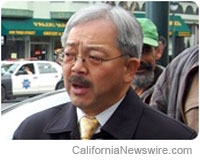 SAN FRANCISCO, Calif. /California Newswire/ — On Wednesday, SF Mayor Edwin M. Lee joined the San Francisco Municipal Transportation Agency (SFMTA), the San Francisco Police Department (SFPD) and San Francisco Department of Public Health to announce the draft Pedestrian Strategy is nearing completion. City officials, advocates and community groups reaffirmed their commitment to pedestrian safety during the holiday shopping season today at the Powell Street Promenade where existing pedestrian improvements have helped holiday shoppers stay safe on busy San Francisco sidewalks.
SAN FRANCISCO, Calif. /California Newswire/ — On Wednesday, SF Mayor Edwin M. Lee joined the San Francisco Municipal Transportation Agency (SFMTA), the San Francisco Police Department (SFPD) and San Francisco Department of Public Health to announce the draft Pedestrian Strategy is nearing completion. City officials, advocates and community groups reaffirmed their commitment to pedestrian safety during the holiday shopping season today at the Powell Street Promenade where existing pedestrian improvements have helped holiday shoppers stay safe on busy San Francisco sidewalks.
As outlined in the Pedestrian Safety Executive Directive, the Pedestrian Strategy will reduce serious or fatal pedestrian injuries by 25 percent by 2016 and by 50 percent by 2021, increase walking and make all neighborhoods safe for pedestrians. Mayor Lee will finalize the plan early next year.
“Whether we are at the beginning or end of our trip, we are all pedestrians at some point,” said Mayor Lee. “This strategy will help make those trips safer and more attractive for those who walk around our beautiful City. The strategy will come to my desk with specific actions and a roadmap to cement our commitment to safer, more walkable streets for everyone.”
“We have a great opportunity in San Francisco to make our streets safer for people on foot, while we improve how our rights-of-way work for all modes of transportation,” said SFMTA Director of Transportation Ed Reiskin. “Strategic and targeted investments can significantly improve the pedestrian realm, making San Francisco an even more enjoyable city on foot. Residents, employees, visitors, and businesses all benefit from a safer, more inviting, more walkable San Francisco.”
“The San Francisco Police Department is committed to keeping our roadways and intersections safety this holiday season for pedestrians,” said SFPD Chief Greg Suhr. “We will accomplish this through targeted traffic enforcement, DUI Checkpoints and driver education.”
The Pedestrian Safety Task Force includes 13 city agencies and groups who identified important short term improvements. The strategy will identify four key goals with related targets and measures:
• Reduce pedestrian injuries;
• Reduce neighborhood injury inequalities;
• Increase walking trips; and
• Provide high-quality walking environments.
The strategy will also lay out objectives ranging from physical improvements, pilot treatments, to more programmatic efforts, such as enforcement, outreach campaigns, and additional data collection and analysis.
“Walk San Francisco and its members look forward to a strong and effective Pedestrian Strategy to fix the 50 miles of San Francisco’s most dangerous streets and meet the Mayor’s goals,” said Walk San Francisco Executive Director Elizabeth Stampe. “This will mean calming traffic on wide, fast arterials like Geary, and creating more sidewalk space and greening with innovative projects like the Powell Promenade. Strategic enforcement is also critical, so police can use data to prevent traffic crimes just like any other crimes. San Francisco can lead the way to make the most sustainable mode of transportation–walking–safe and comfortable for everyone.”
Since the City launched an innovative pedestrian program in 2000, injury collisions involving pedestrians declined by 25 percent. Through better design and operation of the transportation system along with improved driver and pedestrian attention, most collisions are avoidable.
Through the City’s interdepartmental Better Streets Plan, SFMTA Sustainable Streets has been developing new pedestrian safety policies that incorporate best practices and leading research from around the country. According to the new SFMTA policies, the Agency has implemented pedestrian safety strategies, such as roadway narrowing or “road diets” and sidewalk widening; ongoing neighborhood traffic calming projects; pedestrian countdown signals, which reduce accidents at intersections by 22 percent; and other pedestrian safety engineering improvements.
Most recently, the SFMTA has retrofitted existing marked crosswalks on arterial streets by installing continental crosswalks with wide horizontal stripes, advance yield lines or “sharks teeth” and “Yield Here to Pedestrians” signs. Additionally, the pedestrian safety program is restricting parking in advance of some crosswalks where parked vehicles might otherwise obscure the sight lines between motorists and people stepping off of the curb. Since the crosswalk improvements began in November 2009, 46 intersections have received the complete set of improvements. Overall, 180 intersections have been identified citywide to receive these improvements.
Also, as part of its comprehensive approach to improve pedestrian safety citywide the agency is adding additional guards for its School Crossing Guard Program at key intersections, while dedicating a Parking Control Officer to enforce parking regulations around schools with safety concerns. In addition to the School Crossing Guard Program, the SFMTA leads various programs and initiatives to improve safety around our schools, including Safe Routes to Schools, crosswalk improvements and lower speed zones for schools. In April, the SFMTA completed the installation of 15-mile-per-hour speed zones around 181 K-12 public and private schools citywide. To alert motorists to increased enforcement, 803 signs went up around all the San Francisco schools that were eligible under a 2008 State law, which allows the 15-mph zones on two-lane streets for 500 feet around a school.







